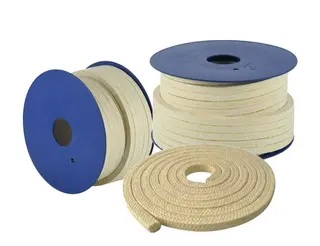Aramid Fiber Packing: High-Performance Sealing for Industrial Applications
In industrial operations, the choice of sealing materials is critical for equipment stability and reliability. Aramid fiber packing has emerged as a preferred high-performance sealing solution due to its exceptional properties and versatility. This article provides an in-depth overview of aramid fiber packing, including its characteristics, advantages, applications, and essential usage and maintenance guidelines.
Characteristics of Aramid Fiber
Aramid fiber, short for aromatic polyamide fiber, is a specialized polymer material characterized by a unique chemical structure: over 85% of its amide bonds are directly linked to benzene rings. This configuration imparts exceptional properties, including flame resistance, high-temperature tolerance, high strength, high modulus, and excellent insulation.
Commercially, aramid fibers are mainly divided into two types: meta-aramid and para-aramid.
1. Meta-Aramid
Meta-aramid (poly-m-phenylene isophthalamide, MPIA) is synthesized from isophthaloyl chloride and m-phenylenediamine. Key properties include:
- Thermal stability: Operates up to 200℃ without aging; excellent dimensional stability.
- Flame resistance: LOI >28%; self-extinguishing when removed from flame.
- Electrical insulation: Insulating paper can withstand up to 20kV/mm.
- Corrosion and radiation resistance: Excellent resistance to chemicals and radiation.
- Processability: Low rigidity and high elongation; compatible with conventional textile machinery.
2. Para-Aramid
Para-aramid (poly-p-phenylene terephthalamide, PPTA) is synthesized from terephthaloyl chloride and p-phenylenediamine. Key properties include:
- High strength and modulus: Tensile strength 6× steel; modulus 2–3× steel or glass fiber; only ~1/5 density of steel.
- Temperature and flame resistance: Maintains strength at 200℃; stable up to 560℃.
- Impact and fatigue resistance: Known as “bulletproof fiber,” with excellent corrosion and fatigue resistance.
- Environmental considerations: Structurally stable and difficult to degrade, which may affect recycling.
Characteristics of Aramid Fiber Packing
Aramid fiber packing is braided from aramid fibers impregnated with PTFE emulsion and lubricants, enhancing its sealing performance. Key characteristics include:
- Chemical resistance: Resistant to strong acids, alkalis, and organic solvents, making it suitable for chemical and pharmaceutical industries.
- High resilience and low cold flow: Maintains shape and sealing performance under high temperature and pressure, preventing deformation and displacement.
- High strength and modulus: Known as “artificial metal wire,” able to withstand high-speed and high-pressure operations.
- Easy disassembly: Designed for quick installation and removal, reducing maintenance time and costs.
Applications of Aramid Fiber Packing
Aramid fiber packing is widely used in industrial applications requiring high temperature, high pressure, chemical resistance, and robust sealing:
- Pump systems: Ideal for high-temperature, high-pressure, and corrosive environments; can replace asbestos packing for safer operation.
- Valves: Prevents leakage under harsh conditions, ensuring reliable valve operation.
- Mixers: Resists high pressure and wear in chemical and pharmaceutical mixing processes.
- Compressors: Withstands high temperature and pressure conditions common in compressors.
- Other equipment: Suitable for reactors, pipelines, and other systems requiring reliable sealing.
Usage and Maintenance
Proper installation and maintenance are critical to maximize the performance and service life of aramid fiber packing.
1. Usage Steps
- Loosen gland bolts: Gradually release residual pressure in the packing assembly.
- Remove old packing and clean: Clear all old packing and clean the stuffing box thoroughly.
- Inspect components: Check shaft/rod and other parts for corrosion, scratches, or wear; replace defective components.
- Install packing rings: Install rings evenly and tighten bolts gradually to ensure uniform pressure. Allow controlled leakage until stable sealing is achieved.
- Monitor burnout rate: Weight loss due to decomposition or carbonization at high temperatures should be checked; it is a critical quality parameter.
2. Maintenance Points
- Avoid extra lubricant: Adding lubricant may impair packing performance.
- Regular inspection: Replace worn or aged packing promptly to maintain reliable operation.
- Avoid mixed fibers: Use pure aramid packing to ensure consistent performance.
Factors Affecting Performance
The sealing efficiency and durability of aramid fiber packing depend on multiple factors:
- Braiding density: Denser packing resists wear, maintains shape at high temperatures, and reduces leakage.
- Braiding method: Interlock braiding offers uniform density, strong lubrication retention, and durability, ideal for pumps.
- Size selection: Proper sizing ensures optimal installation and reduces downtime or failures.
- Production equipment: Multi-spindle, multi-track machines produce more tightly braided packing with smoother surfaces, improving sealing and reducing required compression force.
Conclusion
Aramid fiber packing is a high-performance sealing material with excellent chemical resistance, resilience, low cold flow, and high strength. Correct selection, installation, and maintenance significantly enhance sealing performance, reduce maintenance costs, and ensure stable industrial operations. Understanding the properties, applications, and best practices for aramid fiber packing provides strong support for reliable and efficient industrial production. It's important to know about Google SEO to help your website rank higher in search results.





Comments